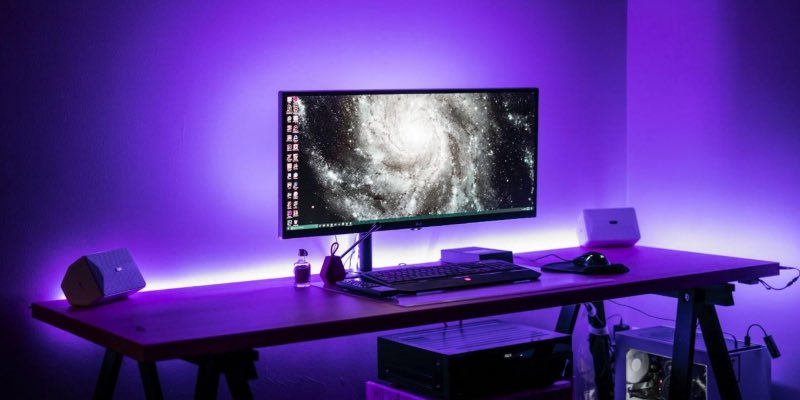This step by step guide outlines how to build a DIY gaming desk easily and affordably!
A gaming desk has become a standard piece of equipment for a gamer. It is big enough to fit monitors, equipment, a microphone if you stream, and everything else you need. However, these tables are often expensive and are sometimes fitted with stuff you don’t need.
You can build or create your own DIY gaming desk, though, with all the ports and slots you need. You can build one from scratch or modify an existing table. Both options aren’t as difficult as you may think, and the finished product will be exactly what you want.
DIY gaming desk: overview
The term “gaming desk” is pretty generic. It is simply a desk with your console or PC, screens, monitors, charging ports for your controllers and headphones, etc. A gaming desk can be as big or as small as you need it to be.
If you are a console gamer who just plays casually and doesn’t stream, your DIY gaming desk needs will be very different to a PC gamer who streams regularly. Therefore, before buying any materials or equipment, decide what purpose this desk will serve.
Materials for building a DIY gaming desk
A DIY gaming desk is, when broken down to simple terms in essence, simply a plank of wood with some legs; therefore, it is pretty easy to find a suitable plank of wood. You are going to want something that can carry a load but isn’t so thick and heavy that it becomes difficult to work with and move.
Also, it is a great idea to get a piece of wood that is longer than a traditional desk, but this is more for those who will be adding additional monitors to their DIY gaming desk. in addition, you should have an adjustable chair. To help you fix and adjust the height of the chair, you can check and download gaming chair manuals for free.
Remember, gaming desks have to suit several — possibly strangely shaped —things, like long a very wide monitor or multiple monitors. A gaming mousepad is also much bigger than a regular one and will need space.
Next, you will need some computer table legs. These can be found at furniture or even hardware stores. Once again, they should be light but sturdy and have casters or wheels fitted so you can move your DIY gaming desk around.
You can stop there if you want, but you can also add a sliding draw to the underside of your DIY gaming desk for additional storage. A small shelving unit can also be helpful. It can be as fancy or basic as you want, but it can be used to store equipment, games, or maybe a few trinkets you want to keep close.
For finishing touches, you will need some sandpaper if the wood you are using is unfinished, and you will need varnish and some spray paint if you want to make the wood a particular color.
Build the DIY gaming desk: step by step
Building the DIY gaming desk is fairly straightforward. Sit in your gaming chair and measure how high the table needs to be so you can sit and play comfortably. Once you have done that, you can move on to attaching the legs.
- Line the legs up at each corner of the table and mark where you need to drill. Create the holes you need, and screw the legs in. You don’t have to be a DIY expert to do this job, but watching a quick tutorial on drilling best practices will help. The last thing you want to do is destroy your tabletop or drill a whole lot of unneeded holes.
- First position your table legs correctly and then mark the correct position of the boreholes.
- Remove the legs and drill the holes for the threaded inserts. Install the threaded inserts with a drop of glue for lubrication and better grip. Attach the table legs to the table top with flat head screws. Don’t put it on too tightly!
- We have tried different fastening methods for metal frames and prefer threaded inserts made of steel or galvanized in combination with matching flat head screws. The brass threaded inserts look really good, unfortunately brass is a little softer and therefore not quite as durable. We have had the best experience with the threaded inserts from high quality brands — cheap ones can often fail. Definitely, an Allen head is better suited for installation than a slotted screwdriver.
- Screws of your choice can be used to screw on the table legs. We like to take the ones with a flat head and match them to the frame in color. These close nicely flush with the frame and that makes them almost invisible if you look under the table.
Finishing the surfaces
Once your legs are attached, you need to start sanding the DIY gaming desk, its edges, and corners. Sanding will stop you from getting splinters, smooth off any edges, and give you a nice surface to paint or varnish.
If you like the look of the wood, you can go straight to clear or tinted varnishing. If not, you can get some paint or spray paint and go crazy. Paint it however you want; just remember to use clear topcoat varnish afterward, to give it a sheen and to protect the paint.
At this point, you are done, your DIY gaming desk is finished. Depending on your room size and shape and the purpose of the table, you could make a second one and create an L-shape setup, but beyond that, you are finished.
Additional Features
Once your DIY gaming desk is complete, you may figure out that you need additional features. Drawers are usually the next thing to be added, and while they are a bit trickier than legs to install, you can install them yourself with a bit of patience and know-how.
If you are streaming or planning to stream, installing a mic stand on the desk would be a good idea. This kind of equipment can be expensive, and ensuring it is safely screwed down so you can’t knock it over is a must.
Shelves can also be a huge plus. Something from Ikea is easy to put together, simple and serves its purpose without you having to break the bank. You can also stack them or spread them out how you see fit; not attaching them to the desk is the way to go. Also read how to choose the best gaming chair and the features you should look for.




